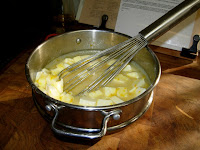This recipe for Sweet Potato Tart Tatin, (that's "tart" without an "e," presumably because this dessert is as American as the sweet potato), comes from DamGoodSweet, a book of "New Orleans style desserts," by David Guas and Raquel Pelzel. Don't know them and haven't tried anything else from this cookbook but, judging by this dish, it looks promising.
If you can call a sweet potato dish sophisticated, this is it: sweet potatoes, sliced thin, layered on top of a rich French caramel, and covered with buttery puff pastry. This is sweet potatoes all grown-up and going to the prom. And the best part? I get to use one of my cast iron skillets. I always feel more authentic when I use a cast iron skillet.
A few preparation tips. Choose long, slender potatoes of relatively even width (about three medium). For slicing I prefer to use my Cuisinart equipped with the slicing disc, but a mandoline slicer would also work nicely. Unless you really want to make your own puff pastry, (get a life already), I recommend using store-bought frozen puff pastry sheets. They're quite good and nobody will know the difference unless you tell them. Finally, once removed from the heat, caramel hardens quickly. Pour fast and spread evenly. If it gets too stiff to spread, set the skillet over the burner for a few seconds to soften.
It may not be a Tart (no 'e') Tatin in the strictest sense of the word, (unless you consider the sweet potato a fruit, and who am I to judge), but it is delicious. Sweet enough, but not too sweet, (Seriously, where I come from most people would consider this a side dish.), served warm or chilled, with ice cream, whipped cream or unadorned; this is not your Mother's sweet potato pie. But it might be yours.
Sweet Potato Tart Tatin
1 sheet frozen puff pastry, thawed
3/4 cup sugar, plus 1 tablespoon for pastry
1/4 cup water
1 stick unsalted butter, cut into cubes
2 teaspoons vanilla
1/8 teaspoon salt
1 1/2 pounds sweet potatoes, peeled and sliced into 1/8-inch thick rounds
1 egg
1 tablespoon milk
Preheat oven to 375 degrees.
Roll out one sheet of defrosted puff pastry. On floured surface, roll lightly to blend in any seams. Cut out a 10-inch circle. Transfer pastry circle to a parchment lined baking sheet, prick all over with a fork and refrigerate until needed.
Stir together 3/4 cup of sugar and 1/4 cup of water in a small saucepan. Partially cover and bring to boil over medium-high heat. Cook, partially covered, 3 or 4 minutes or until syrup is clear and bubbling. Remove cover and cook until mixture is a light butterscotch color and the temperature reaches 320 degrees. Turn off the heat (the mixture will continue to cook) and measure the temperature until it reaches 350 degrees (this will only take a few minutes), whisk in the butter, a few cubes at a time, thoroughly blending after each. Stir in the vanilla and the salt. Pour quickly into a 10-inch cast iron skillet, spreading evenly across the bottom.
Layer the sliced potatoes over the caramel, starting in the center and overlapping in a spiraling outward circle as you go. Top with the puff pastry, tucking it in round the edges of the skillet.
Mix the egg and the milk together and brush over pastry. Then dust with the remaining 1 tablespoon sugar.
Bake about 40 to 45 minutes, until the edges are brown and the pastry is puffed and golden. Allow to cool for at least 15 minutes (up to an hour). Invert onto a large plate -- make sure it's larger than 10 inches in diameter as there will be some liquid on the bottom -- and serve.
I really, really love this "pie."









